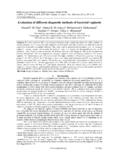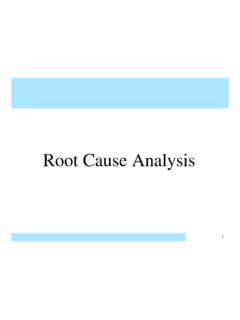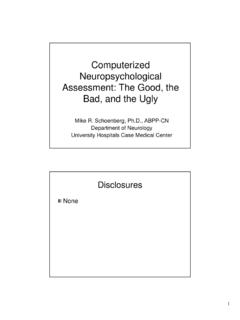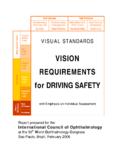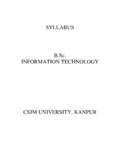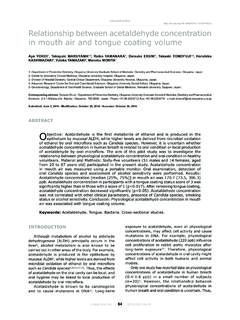Transcription of Near Infrared Spectroscopy – An Overview
1 Near Infrared Spectroscopy An OverviewBackgroundTheoryUses -Industries* Agriculture * Chemical Industry- Production vs. Research* Centralized machine* OnlineLearning Objectives- List the needs to successfully predict sample composition using NIRS- Compare and contrast the advantages and disadvantage of using NIRS vs. wet chemistry - Apply NIRs to your project- Anticipate potential benefits, obstacles, and biasesCaution : I am not a physicist but a user who has gathered this information through the course of my use! Near Infrared Spectroscopy TheoryNear Infrared Spectroscopy NIRSUses the near- Infrared region of the electromagnetic spectrumNear Infrared Spectroscopy An OverviewBASICS.
2 -Specific chemical bonds absorb energy in the NIR amount of energy absorbed by the compound is related to the amount in the sample ( it is quantitative)-Samples are scanned using a near Infrared spectrophotometer that both emits NIR light and detects are measured for composition of predictive equation(s) may be developed by combining the NIRS absorbance data with the chemical to hyperspectralimaging but many more wavelengths-Any trait of interest (protein, micronutrients, etc.) can be attempted, but a successful calibration depends on many in accuracy for speed and cost compared to wet chemistryNear Infrared Spectroscopy An OverviewAdvantages:- No consumables other than lamps ($50 - $1000)- Non-destructive , non-invasive measurement- Sample can therefore be small-Nearly instantaneous measurement- Minimal sample preparation- Continuous real time data can be obtained- Can penetrate far into samples- Can positively ID a pure compound if a library of compounds is developedDisadvantages.
3 - Machines are expensive ($5,000 - $100,000)- Must still measure reduced set of samples with wet chemistry- Calibration is less accurate than wet chemistry- Measurement outside of range of calibration samples is invalid- Small calibration sample sizes can lead to overconfidenceGeneralizedDifferent Approaches Taken Toward NIRS GENERALLYC hemistry,Plant BiologyAgriculture(soil science,agronomy, plant breeding)Type of samplesanalyzedPure compoundsComplex,heterogeneous samplesCalibrations made usingPeak heightor peak area like HPLC / GCComplexstatistical packages and algorithmsType of instrument usedFourier TransformedNear Infrared Spectroscopy (FT-NIRS)Scanning monochrometer(FOSS generally)Reported asWavenumbers (1/ wavelength)Wavelength(Nanometers, nm)Because of this, different people who work on NIRS can speak different languagesThermo Theory higher energy near-IR, approximately 14000 4000cm 1( mwavelength) mid- Infrared , approximately 4000 400cm 1( 25 m) far- Infrared , approximately 400 10cm 1(25 1000 m)
4 NIR light, approximately 14000 4000cm 1 ( mwavelength) can excite overtone or harmonic vibrations in Reflectance vs. TransmissionTwo primary modes- Reflectance* Bounces off samples* Best for solid objects (grain, soil, stover)- Transmission* Pass through samples* Must be liquid or at least not completely opaque* Usually much better calibrations may be developed than reflectancePenetration of samples is much deeper than visible Infrared Spectroscopy Integrating SphereHyperspectralimaging uses filters (like on a camera) to take pictures that include only certain wavelengthsNIRS cover all wavelengths but only at the one point on a you are scanning a heterogeneous sample (such as corn)
5 If the detector is on the embryo you will get a different result than if it is on the endosperm. To average the light over a larger region an integrating sphere is used. Integrating spheres are optical cavities that provide diffuse reflectivity, they diffuse light. The more perfect your integrating sphere the higher your signal-to noise ratio will Infrared Spectroscopy Uses and ApplicationsCrops- Forage quality and composition- Pasture management Fecal nitrogen (FN) and phosphorus (FP) Approved method of the American Association of Cereal Chemists to measure to moisture and protein content in wheat (AACC.)
6 2002. Approved methods of the AACC, Methods 39-10, 39-11, 46-30 and 08-01. St. Paul, Minn.: American Association of Cereal Chemists.)- Ability to measure carotenoidsin maize Brenna OV, BerardoN (2004) Application of near- Infrared reflectance Spectroscopy (NIRS) to the evaluation of carotenoidscontent in maize. J Agric Food Chem52:5577 Sugars in grapes and other fruits Jar nC, Ortu oJC, ArazuriS, Arana JI, SalvadoresMC. Sugar determination in grapes using NIR technology. IntJ Infrared Milli2001; 22: 1521 Oleic acid in single peanut seeds Tillman, B. L.; Gorbet, D. W.; Person, and linoleicacid content of single peanut seeds using near- Infrared reflectance Spectroscopy Crop Sci.
7 2006, 46 ( 5) 2121 Starch gelatinization temperature in rice. J. S. Bao, H. Corke: Pasting properties of -irradiated rice starches as affected by Agric. Food Chem. 2002, 50, 336 341. - Malting quality in barley Ratcliffe, M., and Panozzo, J. F. 1999. The application of near Infrared Spectroscopy to evaluate malting quality. J. Inst. Brew. 105 ADF, NDF, lignin, protein in sorghum leaf and stem Murray, , Rooney, , Mitchell, , Sharma, A., Klein, , Mullet, , and Kresovich, S. 2008. Genetic Improvement of Sorghum as a BiofuelFeedstock: II. QTL for Stem and Leaf Structural Carbohydrates. Crop Science48: Starch, oil, protein, ADF, phosphorus in sorghum grain Murray, , Sharma, A.
8 , Rooney, , Klein, , Mullet, , Mitchell, , and Kresovich, S. 2008. Genetic Improvement of Sorghum as a BiofuelFeedstock: I. QTL for Stem Sugar and Grain Nonstructural Carbohydrates. CropScience 48: NIR light-Etc. Near Infrared Spectroscopy Infrared Spectroscopy Infrared Spectroscopy Uses and ApplicationsSoils- Soil calibrations have generally not performed well across soil types, but accounting for soil organic matter has improved calibrations. Russell, (2003) Sample preparation and prediction of soil organic matter properties by near infra-red reflectance Spectroscopy . Communications in Soil Science and Plant Analysis, 34, Reasonable results have been found with P, Ca, Mg, K, Fe, Mn, S and Na but not pH within Canadian soils.
9 Malley, D. F., Yesmin, L., Wray, D., and Edwards, S. (1999). Application of near- Infrared Spectroscopy in analysis of soil mineral nutrients. Comm. Soil. Sci. Plant Anal. 30, 999 mineralization of nitrogen. Russell, C. A. ,Angus, J. F. ,Batten, G. D. ,Dunn, B. W. andWilliams, R. L. (2002) The potential of NIR Spectroscopy to predict nitrogen mineralization in rice soils. Plant Soil 247 , pp. moisture and organic matter. Hummel et al., 2001. Hummel, Sudduthand Hollinger , Soil moisture and organic matter prediction of surface and subsurface soils using a NIR sensor. Computers and Electronics in Agriculture 32 2001 (2001), pp.
10 149 few publications- Phosphorus, total organic carbon, color, and pH performed marginally. E. D bakk, M. Nilsson, P. Geladi, S. Woldand I. Renberg. Water (2000), p. 1666. - Monitoring bacteria species in water. benefit from spectral subtraction in aqueous Infrared Spectroscopy Uses and ApplicationsIndustrial / pharmaceutical -Place probe in bioreactors to measure:- Target blends in pharmaceutical industry- Fermentation progess-Oil and gas industryHealth- Used to detect tissue oxygenation since 1977- Human skull easily penetrated by NIR light and can be used for neuroimagingof brain parameters StrangmanG, Boas D A and Sutton J P 2002a Non-invasive neuroimagingusing near- Infrared light Biol.
